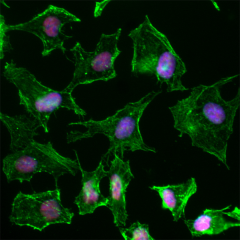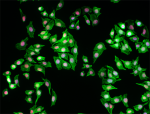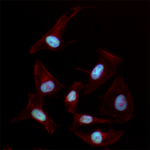- Clone
- 20A1 (See other available formats)
- Regulatory Status
- RUO
- Other Names
- Transcription intermediary factor 1-beta, KRAB-associated protein, TRIM28, KAP-1
- Isotype
- Mouse IgG1, κ
- Ave. Rating
- Submit a Review
- Product Citations
- publications

-

HeLa cells were fixed with 1% paraformaldehyde (PFA) for ten minutes, permeabilized with 0.5% Triton X-100 for ten minutes, and blocked with 5% FBS for 30 minutes. Then the cells were intracellularly stained with 2.5 µg/ml anti-TIF1β (KAP-1, TRIM28) (clone 20A1) Alexa Fluor® 647 (red) in 5% FBS, overnight at 4°C, followed by Alexa Fluor® 488 Phalloidin (green) staining for 20 minutes. Nuclei were counterstained with DAPI (blue). The image was captured with a 40X objective.
| Cat # | Size | Price | Quantity Check Availability | Save | ||
|---|---|---|---|---|---|---|
| 619308 | 100 µg | 278€ | ||||
TIFβ (transcription intermediary factor 1-beta) is an 88 kD member of the tripartite motif family. This protein contains three zinc binding domains, a RING domain, a B-box type 1 and type 2 domain, and a coiled-coil region. TIFβ is found in the nucleus and associates with specific chromatin regions. This protein forms a complex with KRAB-domain transcription factors and recruits SETDB1 to histone 3 to increase KRAB-mediated transcriptional repression. TIF1β has been reported to interact with SETDB1 and CBX3 proteins. Studies using knockout mice reveal the important function of TIF1β in regulating genomic imprinting, T cell activation, and T cell tolerance.
Product DetailsProduct Details
- Verified Reactivity
- Human, Mouse
- Antibody Type
- Monoclonal
- Host Species
- Mouse
- Formulation
- Phosphate-buffered solution, pH 7.2, containing 0.09% sodium azide.
- Preparation
- The antibody was purified by affinity chromatography and conjugated with Alexa Fluor® 647 under optimal conditions.
- Concentration
- 0.5 mg/ml
- Storage & Handling
- The antibody solution should be stored undiluted between 2°C and 8°C, and protected from prolonged exposure to light. Do not freeze.
- Application
-
ICC - Quality tested
- Recommended Usage
-
Each lot of this antibody is quality control tested by immunocytochemistry. For immunocytochemistry, a concentration range of 0.1 - 10 μg/ml is recommended. It is recommended that the reagent be titrated for optimal performance for each application.
* Alexa Fluor® 647 has a maximum emission of 668 nm when it is excited at 633 nm / 635 nm.
Alexa Fluor® and Pacific Blue™ are trademarks of Life Technologies Corporation.
View full statement regarding label licenses - Excitation Laser
-
Red Laser (633 nm)
- Application Notes
-
Additional reported applications (for the relevant formats) include: immunofluorescence1, Western blotting1 and chromatin immunoprecipitation1.
This clone is not recommended for ChIP (Chromatin Immunoprecipitation) assays (as determined by in-house testing).
This clone may produce increased background by western blot when used at concentrations exceeding 0.1 µg/mL. - Application References
-
- Chang CW, et al. 2008 BMC Mol. Biol. 9:61. (WB, IF, ChIP)
- RRID
-
AB_2566637 (BioLegend Cat. No. 619308)
Antigen Details
- Structure
- Tripartite motif family, contains three zinc-binding domains, a RING, a B-box type 1 and 2 domain, and a coiled-coil region. Predicted molecular weight approximately 110 kD
- Distribution
-
Nuclear, associates with specific chromatin regions
- Function
- Forms a complex with KRAB-domain transcription factor and recruits SETDB1 to histone 3 to increase KRAB-mediated transcriptional repression
- Biology Area
- Cell Biology, Immunology, Transcription Factors
- Molecular Family
- Protein Kinases/Phosphatase
- Antigen References
-
1. Ryan RF, et al. 1999. Mol. Cell. Biol. 19:4366.
2. Schultz DC, et al. 2002. Genes Dev. 16:919.
3. Moosmann PR, et al. 1996. Nucleic Acids Res. 24:4859.
4. Friedman JR, et al. 1996. Genes Dev. 10:2067.
5. Messerschmidt DM, et al. 2012. Science 335:1499.
6. Chikuma S, et al. 2012. Nat. Immunol. 13:596. - Gene ID
- 10155 View all products for this Gene ID
- UniProt
- View information about TIF1beta on UniProt.org
Related Pages & Pathways
Pages
Other Formats
View All TIF1β Reagents Request Custom Conjugation| Description | Clone | Applications |
|---|---|---|
| Purified anti-TIF1β (KAP-1, TRIM28) | 20A1 | WB,ICC,ChIP |
| Alexa Fluor® 647 anti-TIF1β (KAP-1, TRIM28) | 20A1 | ICC |
| Alexa Fluor® 488 anti-TIF1β (KAP-1, TRIM28) | 20A1 | ICC |
| Brilliant Violet 421™ anti-TIF1β (KAP-1, TRIM28) | 20A1 | ICC |
Compare Data Across All Formats
This data display is provided for general comparisons between formats.
Your actual data may vary due to variations in samples, target cells, instruments and their settings, staining conditions, and other factors.
If you need assistance with selecting the best format contact our expert technical support team.
-
Purified anti-TIF1β (KAP-1, TRIM28)

Whole cell lysates (15 µg protein) from HeLa, HEK293, and RA... 
HeLa cells were fixed with 1% paraformaldehyde (PFA) for 10 ... -
Alexa Fluor® 647 anti-TIF1β (KAP-1, TRIM28)

HeLa cells were fixed with 1% paraformaldehyde (PFA) for ten... -
Alexa Fluor® 488 anti-TIF1β (KAP-1, TRIM28)

HeLa cells were fixed with 1% paraformaldehyde (PFA) for ten... -
Brilliant Violet 421™ anti-TIF1β (KAP-1, TRIM28)

HeLa cells were fixed with 1% paraformaldehyde (PFA) for ten...
 Login / Register
Login / Register 












Follow Us